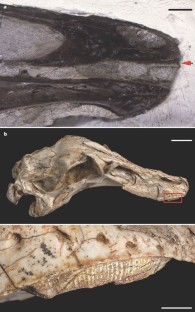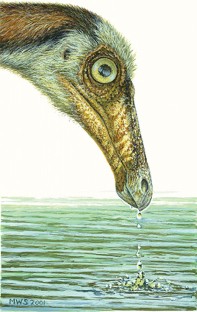The beaks of ostrich dinosaurs (original) (raw)
- Brief Communication
- Published: 30 August 2001
Palaeontology
Nature volume 412, pages 873–874 (2001)Cite this article
- 1064 Accesses
- 65 Citations
- 24 Altmetric
- Metrics details
Abstract
Primitive ornithomimids, a ubiquitous group of specialized Cretaceous dinosaurs nested within a clade of predominantly carnivorous theropods, are known to have had teeth, whereas derived ornithomimids had an edentulous beak, which has prompted speculation about their dietary habits1. Here we describe two new ornithomimid specimens in which soft-tissue structures of the beak have been preserved. These creatures probably used their beaks to strain food sediment in an aqueous environment, rather than for predation on large animals.
This is a preview of subscription content, access via your institution
Access options
Subscribe to this journal
Receive 51 print issues and online access
$199.00 per year
only $3.90 per issue
Buy this article
- Purchase on SpringerLink
- Instant access to full article PDF
Prices may be subject to local taxes which are calculated during checkout
Additional access options:
Figure 1: Two ornithomimid specimens, showing preservation of soft-tissue structures of the beak.

Figure 2

COURTESY OF MIKE SKREPNICK
Similar content being viewed by others
References
- Osmólska, H. in Encyclopedia of Dinosaurs (eds Currie, P. J. & Padian, K.) 499–503 (Academic, New York, 1997).
Google Scholar - Sternberg, C. A. Can. Field-Nat. 47, 79–83 (1933).
Google Scholar - Osmólska, H., Roniewicz, E. & Barsbold, R. Palaeontol. Polonica 27, 103–143 (1972).
Google Scholar - Zweers, G. A., Gerritsen, A. F. & van Kraneburg-Voogd, P. J. in Contributions to Vertebrate Morphology vol. 3 (eds Hecht, M. K & Szalay, F. S.) 1–109 (Karger, Basel, 1977).
Google Scholar - Goodman, D. C. & Fisher, H. I. Functional Anatomy of the Feeding Apparatus in Waterfowl (Aves: Anatidae) 1–193 (South. Illinois Univ. Press, Carbondale, 1962).
Google Scholar - Osborn, H. F. Am. Mus. Bull. 35, 733–771 (1916).
Google Scholar - Kobayashi, Y. et al. Nature 402, 480–481 (1999).
Article CAS Google Scholar - Jerzykiewicz, T. & Russell, D. A. Cretaceous Res. 12, 345–377 (1991).
Article Google Scholar - Currie, P. J. & Eberth, D. A. Cretaceous Res. 14, 127–144 (1993).
Article Google Scholar - Eberth, D. A. in Encyclopedia of Dinosaurs (eds Currie, P. J. & Padian, K.) 379–384 (Academic, New York, 1997).
Google Scholar - Makovicky, P. J. & Norell, M. A. Am. Mus. Novitates 3247, 1–16 (1998).
Google Scholar
Author information
Authors and Affiliations
- American Museum of Natural History, Central Park West at 79th Street, New York, 10024-5192, New York, USA
Mark A. Norell & Peter J. Makovicky - Field Museum, 1400 South Lake Shore Drive, Chicago, 60605-2496, Illinois, USA
Peter J. Makovicky - Royal Tyrell Museum of Palaeontology, Drumheller, T0J 0Y0, Alberta, Canada
Philip J. Currie
Authors
- Mark A. Norell
You can also search for this author inPubMed Google Scholar - Peter J. Makovicky
You can also search for this author inPubMed Google Scholar - Philip J. Currie
You can also search for this author inPubMed Google Scholar
Corresponding author
Correspondence toMark A. Norell.
Rights and permissions
About this article
Cite this article
Norell, M., Makovicky, P. & Currie, P. The beaks of ostrich dinosaurs.Nature 412, 873–874 (2001). https://doi.org/10.1038/35091139
- Issue Date: 30 August 2001
- DOI: https://doi.org/10.1038/35091139